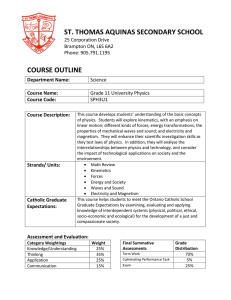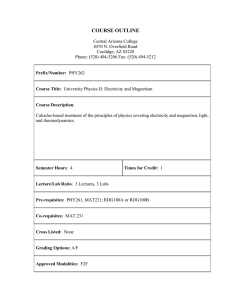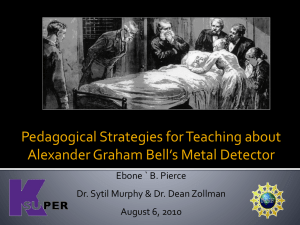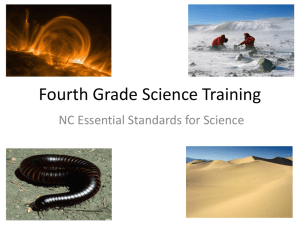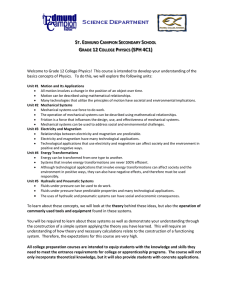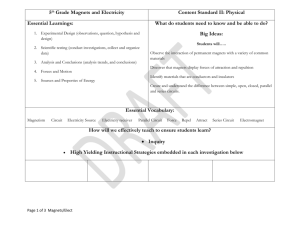Magnetism and Electricity - Boston Schoolyard Initiative
advertisement
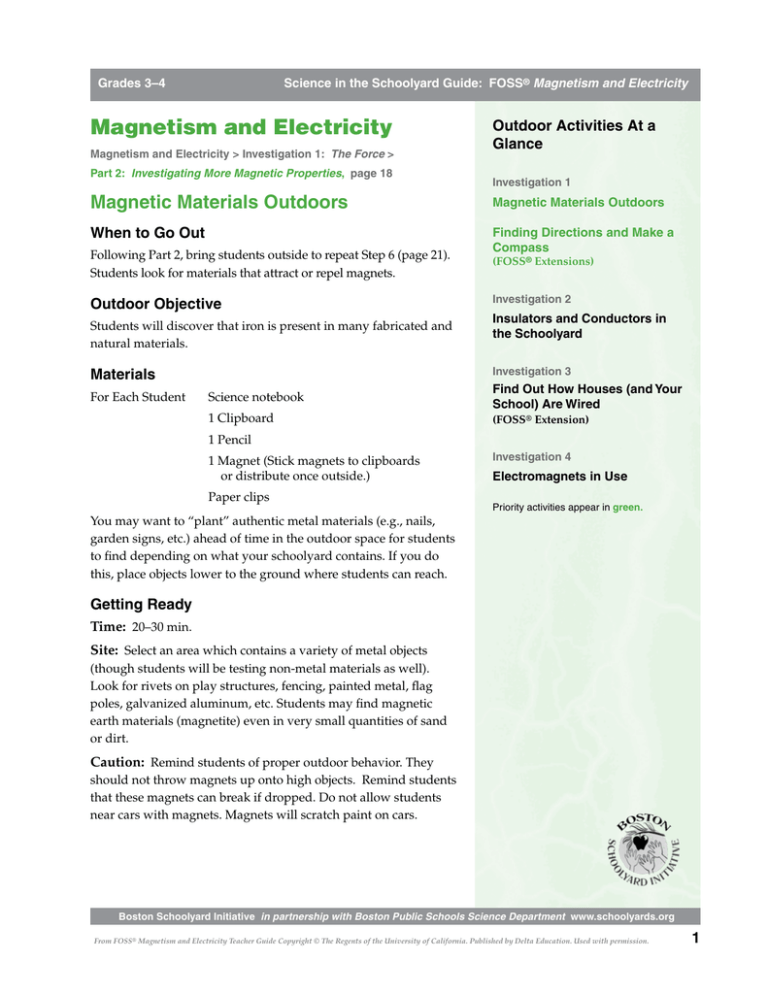
Grades 3–4 Science in the Schoolyard Guide: FOSS® Magnetism and Electricity Magnetism and Electricity Magnetism and Electricity > Investigation 1: The Force > Part 2: Investigating More Magnetic Properties, page 18 Outdoor Activities At a Glance Investigation 1 Magnetic Materials Outdoors Magnetic Materials Outdoors When to Go Out Finding Directions and Make a Compass Following Part 2, bring students outside to repeat Step 6 (page 21). Students look for materials that attract or repel magnets. Outdoor Objective Students will discover that iron is present in many fabricated and natural materials. Investigation 2 Insulators and Conductors in the Schoolyard Investigation 3 Materials For Each Student Science notebook 1 Clipboard 1 Pencil 1 Magnet (Stick magnets to clipboards or distribute once outside.) (FOSS® Extensions) Paper clips Find Out How Houses (and Your School) Are Wired (FOSS® Extension) Investigation 4 Electromagnets in Use Priority activities appear in green. You may want to “plant” authentic metal materials (e.g., nails, garden signs, etc.) ahead of time in the outdoor space for students to find depending on what your schoolyard contains. If you do this, place objects lower to the ground where students can reach. Getting Ready Time: 20–30 min. Site: Select an area which contains a variety of metal objects (though students will be testing non-metal materials as well). Look for rivets on play structures, fencing, painted metal, flag poles, galvanized aluminum, etc. Students may find magnetic earth materials (magnetite) even in very small quantities of sand or dirt. Caution: Remind students of proper outdoor behavior. They should not throw magnets up onto high objects. Remind students that these magnets can break if dropped. Do not allow students near cars with magnets. Magnets will scratch paint on cars. Boston Schoolyard Initiative in partnership with Boston Public Schools Science Department www.schoolyards.org From FOSS® Magnetism and Electricity Teacher Guide Copyright © The Regents of the University of California. Published by Delta Education. Used with permission. 1 Grades 3–4 Science in the Schoolyard Guide: FOSS® Magnetism and Electricity Guiding the Investigation What You Might Find: Students should have already discovered in the test bag that magnetite sticks to magnets. It is rich in iron. Students may find rocks, gravel, or dirt outside that contain iron. Test all types of metal. Magnets may stick to some nails or bolts but not others because some aluminum may be galvanized. 1. Set up notebooks inside. Ask students to first make predictions about what they might find and then make a T-Chart on which to record their findings. 2. Outside students will get their magnets and become “Iron Detectors” as they begin testing what the magnets are attracted to. Students can use the paper clips to look for induced magnetism. 3. After a few minutes, gather students to share findings so that all students can hear about and then try what others have discovered. 4. Give students 5 more minutes to test more objects. 5. When the lesson is complete, discuss why objects are made of the materials they are. Going outside for this investigation removes the danger of students testing magnets by getting too close to electrical outlets, computers, and credit cards. Boston Schoolyard Initiative in partnership with Boston Public Schools Science Department www.schoolyards.org 2 From FOSS® Magnetism and Electricity Teacher Guide Copyright © The Regents of the University of California. Published by Delta Education. Used with permission. Grades 3–4 Science in the Schoolyard Guide: FOSS® Magnetism and Electricity Magnetism and Electricity > Investigation 1: The Force > Part 2: Investigating More Magnetic Properties, page 18 Finding Directions and Make a Compass FOSS® Extensions, page 36 When to Go Out Following Part 2, take students outside with a compass to locate north, south, east, and west. Outdoor Objective Students will experience real-life use of a compass to determine directions. Materials For Each Group 1 Compass Getting Ready Time: 20 min. (Steps 1–5); 20–25 min. (Steps 6–8). Site: Try to work in a location where students can see the Sun. Guiding the Investigation “Students are amazed when they actually see earth materials being attracted to the permanent magnets. Students also induced magnetism using their magnets and the iron fence that is around part of our schoolyard.” Dean Martin Science Specialist 1. Give students a few minutes outdoors to explore using their compasses. 2. Explain that compasses are used to indicate what direction a person is moving in. Teach students to find north by holding the compass level and rotating it so that the N is under the red tip of the arrow. 3. Have students find north and point to it. 4. Help, or have classmates help the students who are confused. 5. Continue the activity by calling out directions and having students point in the named direction. Start slowly and talk through the first few directional calls such as “Point to west”, then move to more challenging calls such as “Point to southwest” or “Point in a northeasterly direction.” 6. If you have time, take this one step further using a series of directional commands to lead students on a “treasure hunt.” Boston Schoolyard Initiative in partnership with Boston Public Schools Science Department www.schoolyards.org From FOSS® Magnetism and Electricity Teacher Guide Copyright © The Regents of the University of California. Published by Delta Education. Used with permission. 3 Grades 3–4 Science in the Schoolyard Guide: FOSS® Magnetism and Electricity 7. Students begin in one spot and follow your verbal or written commands (2 steps to the north, 3 steps to the southeast) to reach a destination such as the flag pole, or an oak tree. What You Might Find: Students have difficulty learning how to read the compass. Be patient with them as you instruct them how to use it. Practice makes perfect. 8. If time allows, challenge students to develop their own “treasure hunt” working in small groups to develop a series of directional commands leading to a spot of their choosing. If you have time, take a minute to discuss where the Sun sets and where it rises. Boston Schoolyard Initiative in partnership with Boston Public Schools Science Department www.schoolyards.org 4 From FOSS® Magnetism and Electricity Teacher Guide Copyright © The Regents of the University of California. Published by Delta Education. Used with permission. Grades 3–4 Science in the Schoolyard Guide: FOSS® Magnetism and Electricity Magnetism and Electricity > Investigation 2: Making Connections > Part 3: Finding Conductors and Insulators, page 20 Insulators and Conductors in the Schoolyard When to Go Out Following Part 3, bring students outside to repeat the lesson. Outdoor Objective Students will determine if objects in the schoolyard are insulators or conductors. Materials What You Might Find: Guide students to try the hardware on the play structures (as well as the other parts), benches, fences, railings, door knobs, plants, rocks, tables, wood, cement, etc. For Each Group 1 Circuit board necklace For Each Student Science notebook 1 Clipboard What You Might Try: 1 Pencil For the Class Extra batteries and wires Students may have already discovered that their magnets were attracted to some objects and not others. Can they make the connection to this lesson with regard to insulators and conductors? If students discovered something with magnetite in it, does it conduct electricity? Getting Ready Time: 15–20 min. (Optional 10-minute discussion about lightning added at end of activity.) Safety Note: Have students look at, but not test, utility poles. Ask them what material the poles are made of and why. Students should be taught not to play near these poles. Take a minute to talk about how students shouldn’t throw things around (or over) power lines, fly kites near them, or climb trees near them. Guiding the Investigation 1. Students should make predictions about what things will be conductors and insulators. Then have them make a T-Chart in their notebooks to record their discoveries. 2. Students should walk around the designated area testing for insulators and conductors. 3. Discuss results and ask, Did anything surprise you? Why are certain things made of conductive materials while others are insulators? Students can brainstorm ideas about why insulators are safer building materials than conductors and about why conductive material is used. 4. Have a discussion about safety during a lightning storm. Boston Schoolyard Initiative in partnership with Boston Public Schools Science Department www.schoolyards.org From FOSS® Magnetism and Electricity Teacher Guide Copyright © The Regents of the University of California. Published by Delta Education. Used with permission. 5 Grades 3–4 Science in the Schoolyard Guide: FOSS® Magnetism and Electricity Magnetism and Electricity > Investigation 3: Advanced Connections Find Out How Houses (and Your School) Are Wired “The kids just have more room to move around and explore outdoors, and I am not as worried about them touching things that they should not.” Erin Flynn Science Specialist FOSS® Extension, page 27 When to Go Out Following the completion of their research (or following Part 3, if students do not do the research extension) go outside to see where electricity comes into the school building and surrounding buildings. Outdoor Objective Students will predict and confirm where the electricity comes into the school building. Getting Ready Time: 5–10 min. Safety Note: Remind students of the dangers of electrical wires. Guiding the Investigation 1. Students may do research on how homes, apartments, or offices are wired. 2. Have students write predictions in their notebooks about where the electricity comes into the school building. 3. Go outside and find out where the electricity comes into the school. 4. Ask students why they think the electrical wires are placed so high up. Ask them to imagine all the wires running through the building. Take a minute to look at all the wires attached to neighboring buildings. 5. If you have streetlights near the school have students think about where the wires are. Ask, Are these parallel or series circuits? You might ask a custodian to join you to help answer questions. Boston Schoolyard Initiative in partnership with Boston Public Schools Science Department www.schoolyards.org 6 From FOSS® Magnetism and Electricity Teacher Guide Copyright © The Regents of the University of California. Published by Delta Education. Used with permission. Grades 3–4 Science in the Schoolyard Guide: FOSS® Magnetism and Electricity Magnetism and Electricity > Investigation 4: Current Attractions > Part 1: Building an Electromagnet, page 8 Electromagnets in Use When to Go Out Prior to Part 1, take this mini field trip. Getting Ready Site: If you happen to teach near a junkyard or a construction site with a crane that has an electromagnet on it, arrange a mini field trip before you begin building electromagnets. Guiding the Investigation “Going outdoors builds enthusiasm and helps connect the science curriculum to the real world.” Erin Flynn Science Specialist Students will be able to see that the crane operator is able to turn the powerful magnet on and off. After observing for a brief time, return to the classroom to begin the investigation. Reminder: At this stage do not yet introduce the term “electromagnet.” Boston Schoolyard Initiative in partnership with Boston Public Schools Science Department www.schoolyards.org From FOSS® Magnetism and Electricity Teacher Guide Copyright © The Regents of the University of California. Published by Delta Education. Used with permission. 7 Grades 3–4 Science in the Schoolyard Guide: FOSS® Magnetism and Electricity Teacher Notes: Boston Schoolyard Initiative in partnership with Boston Public Schools Science Department www.schoolyards.org 8 From FOSS® Magnetism and Electricity Teacher Guide Copyright © The Regents of the University of California. 1293140
